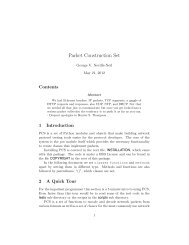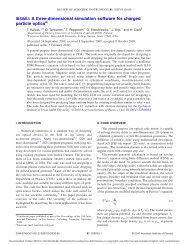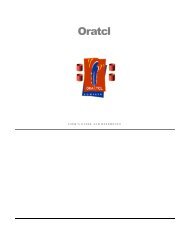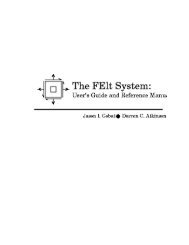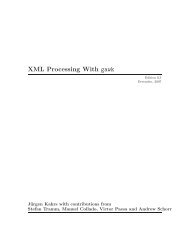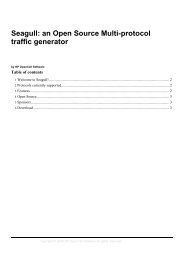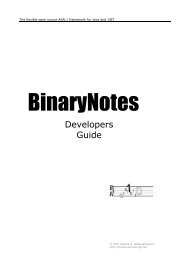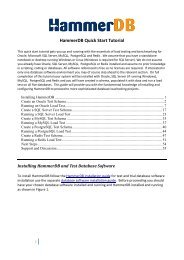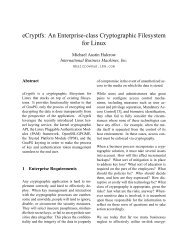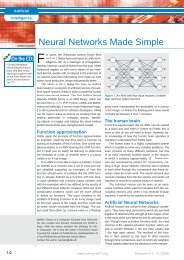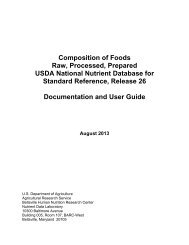System Management Bus (SMBus) Specification, version 2.
System Management Bus (SMBus) Specification, version 2.
System Management Bus (SMBus) Specification, version 2.
Create successful ePaper yourself
Turn your PDF publications into a flip-book with our unique Google optimized e-Paper software.
<strong>System</strong> <strong>Management</strong> <strong>Bus</strong> (SM<strong>Bus</strong>) <strong>Specification</strong> Version <strong>2.</strong>0<br />
3.1.1.4. Master device timeout definitions and conditions<br />
TLOW: MEXT is defined as the cumulative time a master device is allowed to extend its clock cycles within<br />
one byte in a message as measured from:<br />
START to ACK<br />
ACK to ACK<br />
ACK to STOP.<br />
A system host may not violate TLOW:MEXT except when caused by the combination of its clock extension<br />
with the clock extension from a slave device or another master.<br />
A Master is allowed to abort the transaction in progress to any slave that violates the TLOW:SEXT or<br />
TTIMEOUT,MIN specifications. This can be accomplished by the Master issuing a STOP condition at the<br />
conclusion of the byte transfer in progress. 1<br />
3.1.<strong>2.</strong> Low-power DC specifications<br />
3.1.<strong>2.</strong>1. DC parameters<br />
The <strong>System</strong> <strong>Management</strong> <strong>Bus</strong> is designed to operate over a range of voltages between 3 and 5 Volts +/-<br />
10% (<strong>2.</strong>7 V to 5.5 V).<br />
Symbol Parameter Limits Units Comments<br />
Min Max<br />
VIL Data, Clock Input Low Voltage - 0.8 V<br />
VIH Data, Clock Input High Voltage <strong>2.</strong>1 VDD V<br />
VOL Data, Clock Output Low Voltage - 0.4 V at IPULLUP, Max<br />
ILEAK Input Leakage - ±5 µA Note 1<br />
Current through pull-up resistor or 100 350 µA Note 2<br />
current source<br />
VDD Nominal bus voltage <strong>2.</strong>7 5.5 V 3V to 5V ±10%<br />
IPULLUP<br />
Table 2: Low power SM<strong>Bus</strong> DC specification<br />
Note 1: Devices must meet this specification whether powered or unpowered. However, a<br />
microcontroller acting as an SM<strong>Bus</strong> host may exceed ILEAK by no more than 10 µA.<br />
Note 2: The IPULLUP,MAX specification is determined primarily by the need to accommodate a<br />
maximum of 1.1K equivalent series resistor of removable SM<strong>Bus</strong> devices, such as the Smart<br />
Battery, while maintaining the VOL,MAX of the bus.<br />
Because of the relatively low pull-up current, the system designer must ensure that the loading on the bus<br />
remains within acceptable limits. Additionally, to prevent bus loading, any devices that remain connected<br />
to the active bus while unpowered (that is, their Vcc lowered to zero), must also meet the leakage current<br />
specification.<br />
1 A Master should take care when evaluating TLOW:SEXT violation during arbitration since the clock may be held low by<br />
multiple slave devices simultaneously. The arbitration interval may be extended for several bytes in the case of devices<br />
that respond to commands to the SM<strong>Bus</strong> ARP address. If timeouts are handled at the driver level, the software may need<br />
to allow timeouts to be configured or disabled by applications that use the driver in order to support older devices that do<br />
not fully meet the SM<strong>Bus</strong> timeout specifications. Devices that implement ‘shared’ slave addresses may also violate this<br />
specification due to combined clock stretching by the different devices sharing the address. TTIMEOUT,MIN, however, does<br />
not increase due to combined clock stretching. Therefore, this is a safer timeout parameter for a Master to use when it<br />
knows it”s accessing SM<strong>Bus</strong> <strong>2.</strong>0 devices.<br />
SBS Implementers Forum 14



